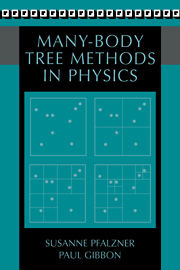Book contents
- Frontmatter
- Contents
- Preface
- Errata
- 1 Introduction
- 2 Basic Principles of the Hierarchical Tree Method
- 3 Open Boundary Problems
- 4 Optimisation of Hierarchical Tree Codes
- 5 Periodic Boundary Conditions
- 6 Periodic Boundary Problems
- 7 The Fast Multipole Method
- Appendix 1 Multipole Expansion in Two Dimensions
- Appendix 2 Spherical Harmonics
- Appendix 3 Near-Neighbour Search
- Refrences
- Index
Appendix 3 - Near-Neighbour Search
Published online by Cambridge University Press: 11 September 2009
- Frontmatter
- Contents
- Preface
- Errata
- 1 Introduction
- 2 Basic Principles of the Hierarchical Tree Method
- 3 Open Boundary Problems
- 4 Optimisation of Hierarchical Tree Codes
- 5 Periodic Boundary Conditions
- 6 Periodic Boundary Problems
- 7 The Fast Multipole Method
- Appendix 1 Multipole Expansion in Two Dimensions
- Appendix 2 Spherical Harmonics
- Appendix 3 Near-Neighbour Search
- Refrences
- Index
Summary
The hierarchical tree method can not be adapted only for Monte Carlo applications: It can also be modified to perform near-neighbour searches efficiently. This means that the tree algorithm could also have applications for systems with short-range or contact forces. Hernquist and Katz (1989) first showed how the tree structure can be used to find near neighbours through range searching. Following their method, the near-neighbour search is performed the following way.
Consider a system in which only neighbours lying within a distance h will interact with the particle i in question. For the near-neighbour search this sphere is enclosed in a cube whose sides are of length 2h. The tree is built the usual way and the tree search starts at the root. The tree search is performed in a very similar way to the normal force calculation of Section 2.2 by constructing an interaction list. The main difference is that the s/d criterion is substituted by the question: ‘Does the volume of the search cube overlap with the volume of the pseudoparticle presently under consideration?’
If there is no overlap, this branch of the tree contains no near neighbours and is not searched any further. However, if there is an overlap, the cell is subdivided into its daughter cells and the search continues on the next highest level. If the cell is a leaf – meaning there is only one particle in the cell – one has to check whether it actually lies within the radius h of particle i.
- Type
- Chapter
- Information
- Many-Body Tree Methods in Physics , pp. 155 - 156Publisher: Cambridge University PressPrint publication year: 1996



